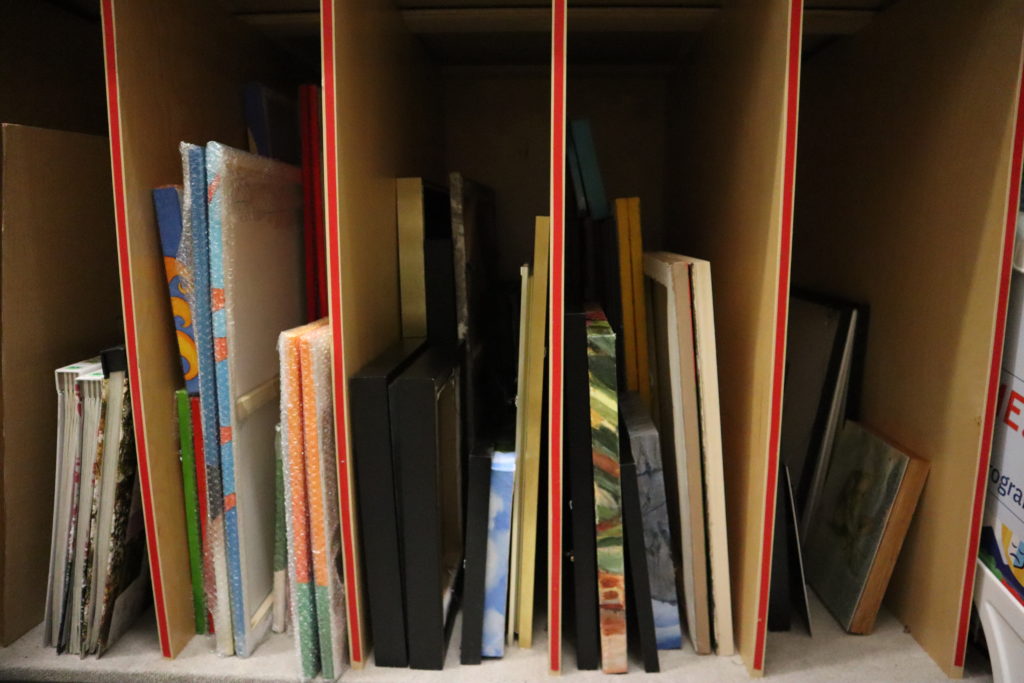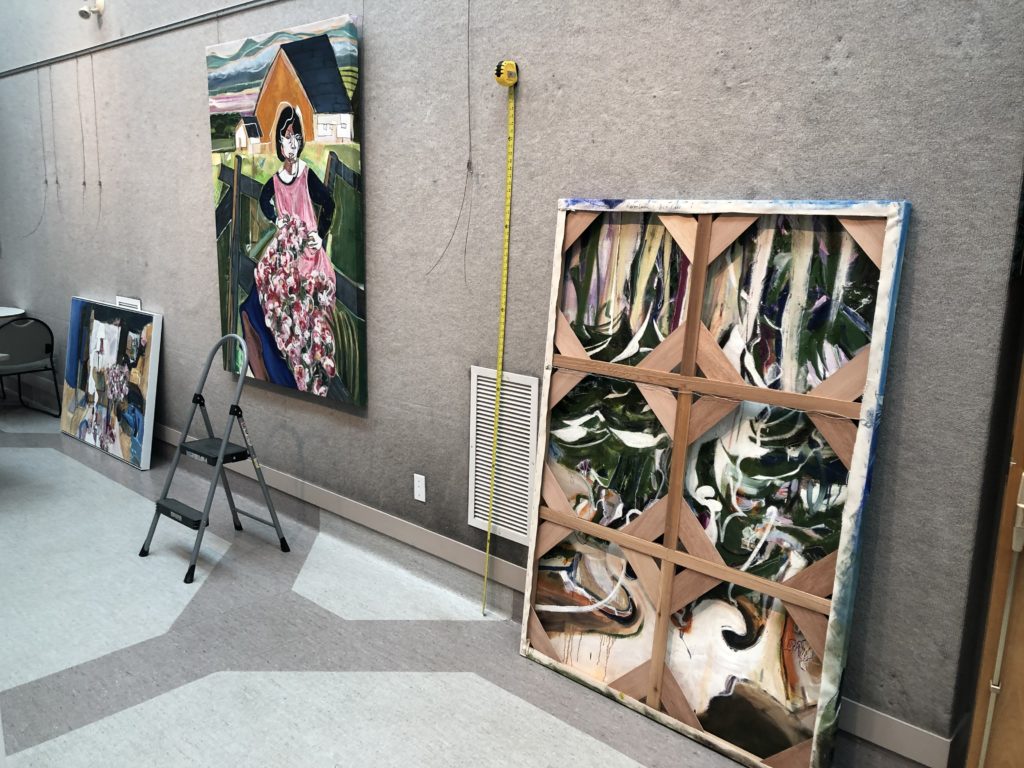Every month from September through June, we host exhibitions to showcase local visual artists in our community. With many diverse styles of work and mediums, from abstract to realistic and sculpture to photography, these exhibitions brighten up our space and inspire many who come through our doors. But what goes into putting an exhibition together?
This month, we followed our Exhibitions Programmer, Kim Correia, as she prepared for our current exhibitions to find out what goes into making our spaces shine.
BACKGROUND
Place des Arts has three spaces where exhibitions take place; the Atrium, the Mezzanine and the Leonore Peyton Salon. Every year we put a call out for artists to apply to exhibit in one of our spaces. Once the applications are received, a jury reviews the submissions and provides a list of accepted submissions. Then, the season is programmed by Kim “around three main factors: artist preference, space availability and what type of artwork is proposed.” Once a schedule is drafted, Kim reviews it and sees if there are thematic connections that can be made between exhibitions happening at the same time.
After the artists have been confirmed, and the dates have been set, Kim is ready to prepare for displaying the art.

RECEIVING THE ARTWORK
The first step of any exhibition is receiving the artwork. Kim works with the artists to arrange a date for drop-off. Depending on the size of the pieces and the amount of work, drop-off sometimes happens prior to the installation day and the works are put in storage. If the works are large or there are too many to fit in our storage space, Kim will arrange with the artists to drop-off the artwork the same day it will be installed.
We asked Kim what the best aspect of artwork drop-off is and she had this to say: “Drop-off is exciting because often I have seen the works digitally but seeing the works in person always reveals elements that digital images can’t communicate such as surface texture or brushstrokes that get flattened in a digital image. In February, when Marlene Lowden brought in her 64” canvas Blind Contour Homage: Carr I was absolutely blown away! It’s one thing to imagine an incredible person-sized piece of art but it’s another to encounter it in real life!”
[Image: Paintings stored for display]
DE-INSTALLATION
Next is the de-installation of the current exhibitions. If there are exhibitions hung (which is almost always the case) Kim works with the artists to de-install their work. Artwork must be handled with care and often they will pack each work individually before loading them into the artists’ vehicle. As with most things, taking down a show is always quicker than putting it up!
We asked Kim about the time in between exhibitions and she said “When an exhibition has been on display for a few weeks you start to get comfortable with the visual atmosphere the exhibition creates. Then, when the work comes down and the space is empty, it is always a reminder of the impact each exhibition has in transforming the space. The empty walls between exhibitions allow the space to be ‘reset’ in a sense, before I start thinking about installing the next exhibition.”
 START INSTALLING
START INSTALLING
To get the exhibitions ready for the opening reception, Kim works with one of our volunteers, Challen, to install the exhibitions. Before anything is measured or hung, all artworks are unwrapped, 2D work is leaned up against the walls and 3D work is set out on tables. Seeing all the works together in the exhibition space helps Kim determine which pieces will go where. As part of the application, artists submit an exhibition concept. With installation, Kim states “it is my job to make sure the artworks are displayed in a way that compliments the artist(s)’ vision.”
[Image: Measuring the wall for hanging]
For example, sometimes the layout is important to the artist and Kim works with their intention for hanging the show. However, other artists prefer leaving the layout up to Kim. For Kim, “curating an exhibition is my favourite part of this process. It’s a time when I can be creative and think about what narrative the exhibition will tell as the viewer walks through the space.”
According to Kim, the layout is based on a few factors: the size of the wall, the size of the work, and the visual components of the work. In order to hang an exhibition that is visually balanced, it is important to consider how colours, textures, patterns and content flow from one artwork into the next throughout the space. For example, there might be a piece that initiated the series for the artist or inspired the exhibition concept so that piece might end up towards the beginning of the exhibition where viewers will see it first. Or there may be works that complement each other that “ask” to be hung adjacent to each other. Kim states, “as much as I am making decisions about how to install the artwork, I am really responding to the visual elements and the content in each work to build the exhibition narrative.”
Often this process takes some time and the layout might change multiple times before anything is hung on the wall or put in a display case. Our wire and hook system also allows for lots of flexibility with hanging, so if Kim changes her mind once a work is hung, it can always be moved! Once the artworks are measured and hung, then the works are leveled and spaced.
For Kim, “no two exhibitions are the same and each installation presents new challenges, but I really enjoy the creative problem solving involved during installation!”
The installation process usually takes about a day or two, and the next few days are for the final touches. The last step is labelling the works, and one of our long-time volunteers Lois assists with this important step.
OPENING RECEPTION
After all three exhibitions are installed, we host an opening reception, where the public is invited to view the art, enjoy a glass of wine, meet the artists and get inspired! These events are free to attend.
Take a look at our events schedule to see when the next one is happening. Every month the date is different, but they are always on a Friday from 7-9 pm.